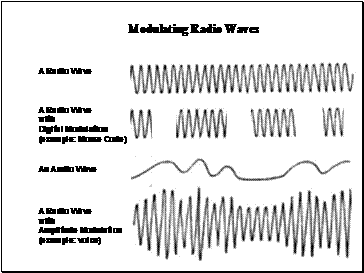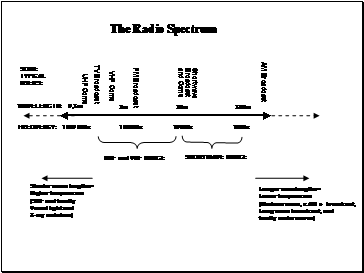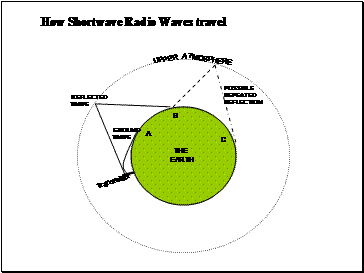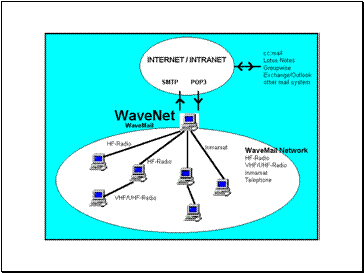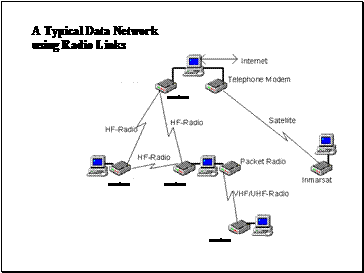Illustration 4.1
To transport information on a radio wave, we can switch the transmitter on and off.
The resulting pulses carry the information. One example for such a digital modulation is morse code: The sequence « short-long-long-short » shown above represents the letter « P ».
To transmit voice, we can change the strength of the radio wave in the rhythm of the audio wave. The result is Amplitude Modulation (AM).
We could also change other characteristics, such as the frequency of the wave. This would result in Frequency modulation (FM).
Illustration 4.2
The characteristics of the radio waves carrying information depends on their frequency or wavelength. The wavelength also determines the necessary size of antennas for the different frequencies. Typical sizes are ¼ or ½ of a wavelength.
Abbreviations:
VHF = Very High Frequency
UHF = Ultra High Frequency
MHz = 1 million cycles per second
The shorter their wavelength (and therefore their higher the frequency), the more the radio waves behave like light waves, travelling only in a straight line.
Illustration 4.3
Radio waves of the shortwave range travel mostly in two ways: along the surface of the earth, and towards the upper layers of the atmosphere, where they are reflected back to the surface.
If and at which angle they are reflected, depends not only on their frequency or wavelength, but also on the electric charge, the degree of ionisation in various layers of the upper atmosphere. Time of the day as well as solar activity (sunspots) influence the degree of reflection.
The ground wave typically has a range of a few kilometers or tens of kilometers. Waves reaching the reflecting layers in a very steep angle, will not be reflected effectively. Between points A, the limit of groundwave proagation, and point B, the first point where the reflected waves reach the surface, lays a « dead zone », in which communication is not possible. Beyond point B, multiple reflections in the atmosphere may, under favorable conditions, reach any point around the globe.
Antennas for long distance communications focus the energy at the most suitable angle for reflection.
A somewhat larger area than that of the ground wave can be reached by using antennas focusing the radiation upwards in a steep angle. This method, called « Near Vertical Incident System » (NVIS) is useful for regional medium-range communication.
As we see from the above, careful planning is required, when shortwave links are to be established. The expertise of a telecommunication technician is indispensable.
Illustration 4.4
« WaveNet » is an example of an emergency network on which the user can work just like « at home »: A PC or laptop computer is connected to a « server », a computer serving as the gateway to the internet. The connection between the PC or laptop and the gateway can be established over a VHF, UHF, HF or satellite link. All these connections can be fully automatic, and the user will need only very little training in the use of the software (not much different from any other e-mail application).
The PC or laptop is connected to the transceiver through a modem, which converts the data into the mode appropriate for the kind of radio link used and back into the format needed by the computer (modem = Modulator and Demodulator).
Illustration 4.5
Each station on the network has an e-mail address; stations can send messages
to any internet e-mail address. To each other they can send messages via the
network gateway of the base station, without being connected directly.
